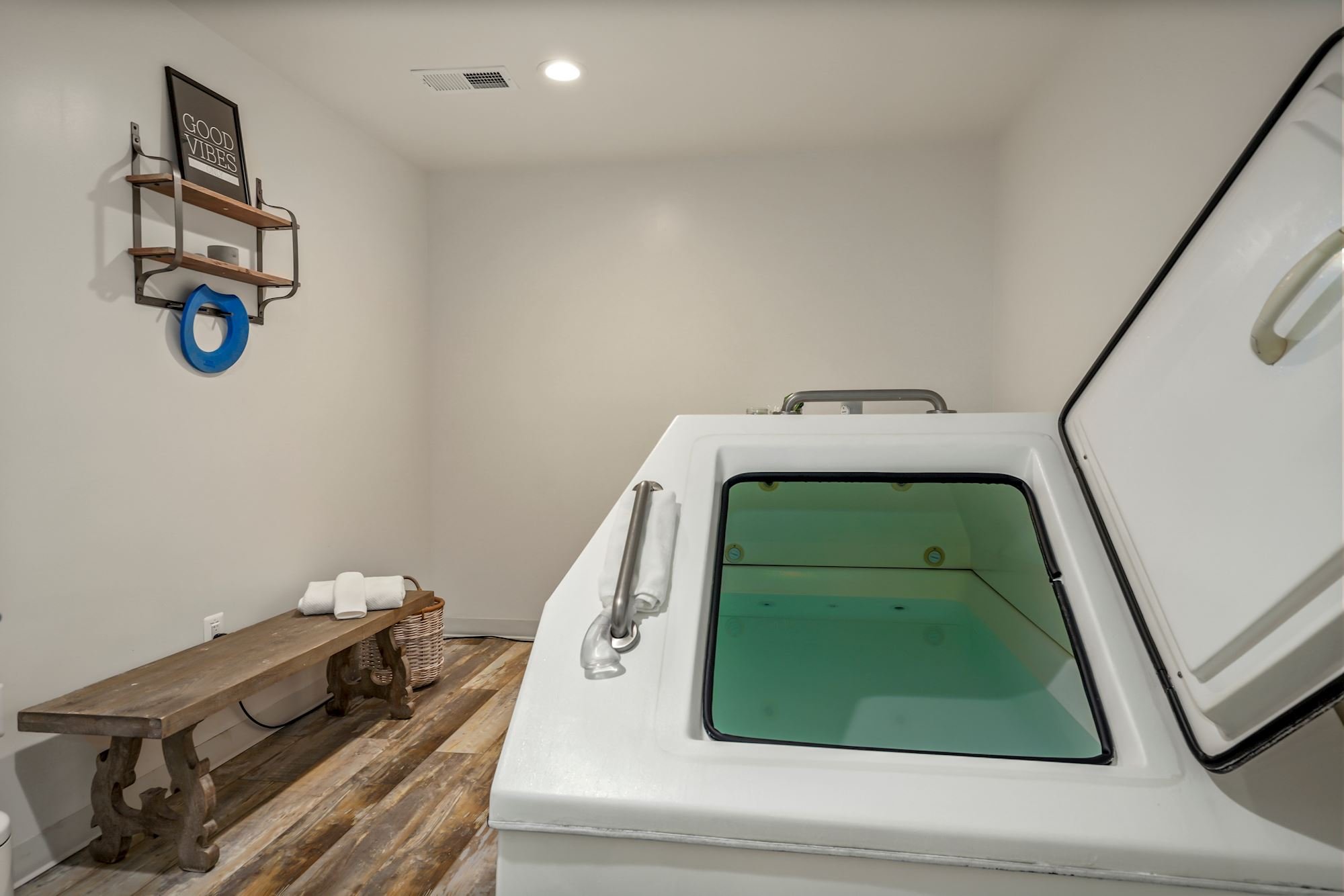
The Benefits of Floating
Floating creates a unique environment that allows for many mental and physical benefits.
Flotation Therapy takes advantage of an innate, natural inclination to relax when floating at a comfortable temperature.
The saltwater is heated to skin temperature and stays 94-95 degrees Fahrenheit throughout your experience.
The temperature is that which allows natural heat generation to escape without the need for muscle action to raise body temperature in homeostasis.
One of the major sources of stimulation in humans is the temperature gradient change on the surface of the body throughout the day.
The temperature inside the float tank is isothermal over the surface of the body so that the nerve endings covering the surface of the skin no longer perceive a separation between the skin and the solution inside the tank.
Find Your Natural Posture
The floating posture, usually the supine position (although the prone position with the chin supported on elbows is recommended for pregnant women), allows all the postural muscles to relax.
The water pressure on the immersed skin is lower than the blood pressure and thus blood flow continues in the skin capillaries. This is in contrast to normal bed rest where local contact pressure inhibits blood flow requiring regular adjustment of posture.
When people cannot adjust their posture in bed, e.g. in some illnesses, bed sores can result. When floating there is no tendency to adjust the posture and a person can float immobile for many hours.
The natural tendency of the body in the floating posture at the correct temperature is to dilate the blood vessels, reducing the blood pressure and maximizing blood flow.
The brain activity normally associated with postural muscles is reduced to a minimum.
In this state, which we can call the floating state, natural endorphins are released reducing pain.
Lactic acid removal is accelerated. Flow in the lymphatic system is increased.
A Zero-Gravity Environment Conserves Energy and Promotes Healing
Finding where gravity is and in which direction, then computing how you can move and not fall over, takes about 90% of your brain’s activity on a daily basis.
Due to the high salt levels in the water, the flotation tank creates a zero-gravity environment. In this situation, the body conserves energy and has a chance to heal and rejuvenate itself.
When you start to float you are free from all the gravity computations and the physical world, which leaves the brain free to attend to other matters. The tank creates a state of sensory relaxation as the mind and body are shielded from all external stimulation.
Unless you are an astronaut the flotation tank is the only situation you will encounter where your body is free from gravity. NASA employs flotation to simulate weightlessness.
Zero gravity allows you to relax every single muscle, your neck, arms, back, and even ears.
The tank enables you to find those areas you are holding tense so you can let go.
Complete Darkness Helps Your Brain Relax
Floating in darkness allows areas of the brain that are always in use when awake to be liberated from their work.
Tests have shown that there is a drop in electrical activity of the brain and you begin to generate theta brain waves, which are associated with deep relaxation.
The darkness during floating also induces a balance between the left and right brain. There is a shift from the normally dormant left side of the brain (logical, analytical, rational) to the right side (intuition, mental clarity, and creativity).
For the first time, both sides of the brain are in harmony and the balance creates allows you to use huge amounts of previously unavailable brainpower.
Some of the amazing benefits of floating
Aid Concentration
Heal the Body
Aid Sleep
Boost Creativity
Intense Relaxation
Aid Depression
Those who regularly utilize flotation therapy in their wellness programs report an array of positive long-term and short-term benefits.
Some of the most common benefits include:
Intense Relaxation
Relieve old injuries (especially back aches etc.)
Ease Arthritis
Release Endorphins – the body’s natural pain killer and happy pill
Improve the condition of the skin
Detoxify the system
Useful in pregnancy (for the full 9 months)
Increase creativity and imagination
Increase circulation and energy levels
Balance the left and right brain
Improve concentration
An aid for addictions, phobias, and depression
Regulate sleeping patterns – simulates 4 hours of sleep
Relieve stress
The deep mental relaxation initiated by floating allows the brain to produce a greater amount of theta waves, which are accompanied by an increase in mental clarity, creativity, imagery, and memory. In addition, the release of endorphins induces the feeling of elevated mood states which are effective in helping alleviate anxiety, depression, and negative mental habits.
Benefits of Floating in Saltwater
Most float tanks use Epsom salt, magnesium sulfate, in high concentration so that the relative density of the solution is about 1.25 (1.3 is very close to re-crystallization).
The density assists floating particularly making the head buoyant so that the nose and mouth are well out of the water for breathing.
Magnesium is absorbed through the skin due to natural molecular diffusion. This tends to correct magnesium deficiency.
Magnesium is absorbed from the diet but in many areas of the world, over-cropping without adequate replacement of magnesium makes the normal diet low in magnesium.
The body naturally optimizes the levels of magnesium, so there is no overload effect from floating in the salts for extended periods.
Why you should float regularly:
Frequent Floating Increases Theta Brain Wave Duration
A therapeutic session in a flotation tank typically lasts an hour. For the first forty minutes, it is reportedly possible to experience itching in various parts of the body (a phenomenon also reported to be common during the early stages of meditation).
The last twenty minutes often end with a transition from beta or alpha brainwaves to theta, which typically occurs briefly before sleep and again at waking.
In a flotation tank, the theta state can last indefinitely without the subject losing consciousness.
Many use the extended theta state as a tool for enhanced creativity and problem-solving or for super learning.
The more often you float, the longer the theta period becomes.
Sensory Deprivation Relieves Stress, Anxiety, and Pain.
People using early float tanks discovered that they enjoyed the experience and that the relaxed state was also a healing state for many conditions including stress, anxiety, pain, swelling, insomnia, and jet lag.
Research in Sweden has demonstrated the therapeutic effect on stress and pain.
As a result, float tanks were produced for commercial uses, and commercial float centers offering flotation therapy opened in several countries during the period from 1980 to the present day when there are hundreds of flotation centers in dozens of countries. In almost all cases these float centers offer wellness treatments and in particular the release of stress.
Floating can be passive or active, depending on the purpose. For relaxation, one simply floats and 'clears the mind.'
Active floating has many different techniques. One may perform meditation, mantras, self-hypnosis, utilize educational programs, etc.
The idea of active floating is that, when the body is relaxed, the mind becomes highly suggestible and any action taken during these states will enter the information into the subconscious.
Floating leads to Reduced Cortisol Levels.
Perceived stress can be correlated with increased levels of cortisol and in flotation therapy there is a natural tendency for cortisol to be reduced.
For this reason, flotation therapy is one of the few noninvasive techniques available to manage stress when it is a factor in reducing a person's ability to cope with normal life.
Flotation therapy is a fast technique in this respect. The Swedish research was based on 40-minute float sessions. This compares well with other management techniques such as long vacations.
There are many similarities with the age-old long hot bath, the differences being that in flotation therapy the temperature is maintained at the correct level and the bath is large enough to float without touching the sides of the bath.
Flotation Therapy Improves Creativity, Accuracy, and Focus
Research into flotation therapy (as opposed to just the effect of isolation) began in the USA at Ohio State University where floating was shown to improve creativity in Jazz musicians, accuracy in rifle shooting, focus before academic examinations, and stress relief, among others.
Athletes & Floating
Athletes have found that using float therapy in conjunction with their training program has improved their athletic performance. Every muscle is able to fully rest and recover after being pushed to the limit. Floating can help improve performance, aid in preventing sports injuries, and shorten recovery time.
What normally takes a long period of time (usually days for recovery from a marathon) the flotation tank compresses into a number of hours.
By relieving the stresses of gravity, floating takes the weight off strained bones, joints, and muscles and increases the efficiency of the blood circulating through the body. Improves athletic performance and helps prevent sports injuries, speeding the healing process.
Athletes may also benefit from Contrast Therapy, Fascial Stretch Therapy, or a Deep Tissue Massage before or after floating.

